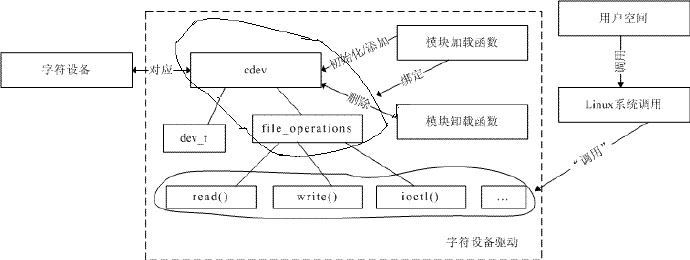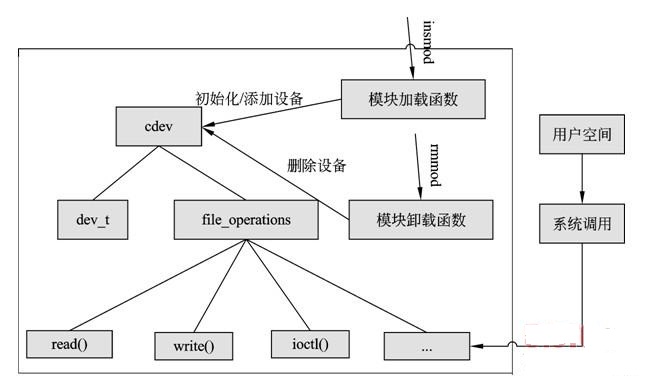1. 字符设备驱动概述
一、linux系统将设备分为3类:字符设备、块设备、网络设备。使用驱动程序:
-
字符设备:是指只能一个字节一个字节读写的设备,不能随机读取设备内存中的某一数据,读取数据需要按照先后数据。字符设备是面向流的设备,常见的字符设备有鼠标、键盘、串口、控制台和LED设备等。
-
块设备:是指可以从设备的任意位置读取一定长度数据的设备。块设备包括硬盘、磁盘、U盘和SD卡等。
每一个字符设备或块设备都在/dev目录下对应一个设备文件。linux用户程序通过设备文件(或称设备节点)来使用驱动程序操作字符设备和块设备。
二、字符设备、字符设备驱动与用户空间访问该设备的程序三者之间的关系。
如图,在Linux内核中使用cdev结构体来描述字符设备,通过其成员dev_t来定义设备号(分为主、次设备号)以确定字符设备的唯一性。通过其成员file_operations来定义字符设备驱动提供给VFS的接口函数,如常见的open()、read()、write()等。
在Linux字符设备驱动中,模块加载函数通过register_chrdev_region( ) 或alloc_chrdev_region( )来静态或者动态获取设备号,通过cdev_init( )建立cdev与file_operations之间的连接,通过cdev_add( )向系统添加一个cdev以完成注册。模块卸载函数通过cdev_del( )来注销cdev,通过unregister_chrdev_region( )来释放设备号。
用户空间访问该设备的程序通过Linux系统调用,如open( )、read( )、write( ),来“调用”file_operations来定义字符设备驱动提供给VFS的接口函数。
三、字符设备驱动模型
2. 相关函数
1.驱动初始化
1.1. 分配cdev
在2.6的内核中使用cdev结构体来描述字符设备,在驱动中分配cdev,主要是分配一个cdev结构体与申请设备号,以按键驱动为例:
/* 分配cdev*/
struct cdev btn_cdev;
/*申请设备号*/
if(major){
//静态
dev_id = MKDEV(major, 0);
register_chrdev_region(dev_id, 1, "button");
}
else //动态分配
{
alloc_chardev_region(&dev_id, 0, 1, "button");
major = MAJOR(dev_id);
}从上面的代码可以看出,申请设备号有动静之分,其实设备号还有主次之分。
在Linux中以主设备号用来标识与设备文件相连的驱动程序。次编号被驱动程序用来辨别操作的是哪个设备。cdev 结构体的 dev_t 成员定义了设备号,为 32 位,其中高 12 位为主设备号,低20 位为次设备号。
设备号的获得与生成:
获得:主设备号:MAJOR(dev_t dev);
次设备号:MINOR(dev_t dev);
生成:MKDEV(int major,int minor);
设备号申请的动静之分:
静态:
int register_chrdev_region(dev_t from, unsigned count, const char *name);
/*功能:申请使用从from开始的count 个设备号(主设备号不变,次设备号增加)*/静态申请相对较简单,但是一旦驱动被广泛使用,这个随机选定的主设备号可能会导致设备号冲突,而使驱动程序无法注册。
动态:
int alloc_chrdev_region(dev_t *dev, unsigned baseminor, unsigned count,const char *name);
/*功能:请求内核动态分配count个设备号,且次设备号从baseminor开始。*/动态申请简单,易于驱动推广,但是无法在安装驱动前创建设备文件(因为安装前还没有分配到主设备号)。
1.2. 初始化cdev
void cdev_init(struct cdev *, struct file_operations *);
cdev_init()函数用于初始化 cdev 的成员,并建立 cdev 和 file_operations 之间的连接。1.3. 注册cdev
int cdev_add(struct cdev *, dev_t, unsigned);
cdev_add()函数向系统添加一个 cdev,完成字符设备的注册。1.4. 硬件初始化
硬件初始化主要是硬件资源的申请与配置
2.实现设备操作
用户空间的程序以访问文件的形式访问字符设备,通常进行open、read、write、close等系统调用。而这些系统调用的最终落实则是file_operations结构体中成员函数,它们是字符设备驱动与内核的接口。以TQ210的按键驱动为例:
1 /*设备操作集合*/
2 static struct file_operations btn_fops = {
3 .owner = THIS_MODULE,
4 .open = button_open,
5 .release = button_close,
6 .read = button_read
7 };上面代码中的button_open、button_close、button_read是要在驱动中自己实现的。file_operations结构体成员函数有很多个,下面就选几个常见的来展示:
2.1. open()函数
原型:int(open)(struct inode , struct file*);
2.2. read( )函数
原型:
ssize_t(read)(struct file , char __user*, size_t, loff_t*);
/用来从设备中读取数据,成功时函数返回读取的字节数,出错时返回一个负值/
2.3. write( )函数
原型: ssize_t(write)(struct file , const char__user , size_t, loff_t);
/*向设备发送数据,成功时该函数返回写入的字节数。如果此函数未被实现,
当用户进行write()系统调用时,将得到-EINVAL返回值*/
2.4. close( )函数: int(release)(struct inode , struct file*);
2.5. 补充说明
在Linux字符设备驱动程序设计中,有3种非常重要的数据结构:struct file、struct inode、struct file_operations。
struct file 代表一个打开的文件。系统中每个打开的文件在内核空间都有一个关联的struct file。它由内核在打开文件时创建, 在文件关闭后释放。其成员loff_t f_pos 表示文件读写位置。
struct inode 用来记录文件的物理上的信息。因此,它和代表打开文件的file结构是不同的。一个文件可以对应多个file结构,但只有一个inode结构。其成员dev_t i_rdev表示设备号。
struct file_operations 一个函数指针的集合,定义能在设备上进行的操作。结构中的成员指向驱动中的函数,这些函数实现一个特别的操作, 对于不支持的操作保留为NULL。
在read( )和write( )中的buff 参数是用户空间指针。因此,它不能被内核代码直接引用,因为用户空间指针在内核空间时可能根本是无效的——没有那个地址的映射。因此,内核提供了专门的函数用于访问用户空间的指针:
unsigned long copy_from_user(void *to, const void __user *from, unsigned long count);
unsigned long copy_to_user(void __user *to, const void *from, unsigned long count);3.驱动注销
3.1. 删除cdev
在字符设备驱动模块卸载函数中通过cdev_del()函数向系统删除一个cdev,完成字符设备的注销
/*原型:*/
void cdev_del(struct cdev *);
/*例:*/
cdev_del(&btn_cdev);3.2. 释放设备号
在调用cdev_del()函数从系统注销字符设备之后,unregister_chrdev_region()应该被调用以释放原先申请的设备号。
/*原型:*/
void unregister_chrdev_region(dev_t from, unsigned count);
/*例:*/
unregister_chrdev_region(MKDEV(major, 0), 1);四、字符设备驱动程序基础:
4.1 cdev结构体
在Linux2.6 内核中,使用cdev结构体来描述一个字符设备,cdev结构体的定义如下:
1 struct cdev {
2
3 struct kobject kobj;
4
5 struct module *owner; /*通常为THIS_MODULE*/
6
7 struct file_operations *ops; /*在cdev_init()这个函数里面与cdev结构联系起来*/
8
9 struct list_head list;
10
11 dev_t dev; /*设备号*/
12
13 unsigned int count;
14
15 };cdev 结构体的dev_t 成员定义了设备号,为32位,其中12位是主设备号,20位是次设备号,我们只需使用二个简单的宏就可以从dev_t 中获取主设备号和次设备号:
MAJOR(dev_t dev)
MINOR(dev_t dev)
相反地,可以通过主次设备号来生成dev_t:
MKDEV(int major,int minor)
4.2 Linux 2.6内核提供一组函数用于操作cdev 结构体
1:void cdev_init(struct cdev*,struct file_operations *);
2:struct cdev *cdev_alloc(void);
3:int cdev_add(struct cdev *,dev_t,unsigned);
4:void cdev_del(struct cdev *);其中(1)用于初始化cdev结构体,并建立cdev与file_operations 之间的连接。(2)用于动态分配一个cdev结构,(3)向内核注册一个cdev结构,(4)向内核注销一个cdev结构
4.3 Linux 2.6内核分配和释放设备号
在调用cdev_add()函数向系统注册字符设备之前,首先应向系统申请设备号,有二种方法申请设备号,一种是静态申请设备号:
5:int register_chrdev_region(dev_t from,unsigned count,const char *name)
另一种是动态申请设备号:
6:int alloc_chrdev_region(dev_t *dev,unsigned baseminor,unsigned count,const char *name);
其中,静态申请是已知起始设备号的情况,如先使用cat /proc/devices 命令查得哪个设备号未事先使用(不推荐使用静态申请);动态申请是由系统自动分配,只需设置major = 0即可。
相反地,在调用cdev_del()函数从系统中注销字符设备之后,应该向系统申请释放原先申请的设备号,使用:
7:void unregister_chrdev_region(dev_t from,unsigned count);
4.4 cdev结构的file_operations结构体
这个结构体是字符设备当中最重要的结构体之一,file_operations 结构体中的成员函数指针是字符设备驱动程序设计的主体内容,这些函数实际上在应用程序进行Linux 的 open()、read()、write()、close()、seek()、ioctl()等系统调用时最终被调用。
1 struct file_operations {
2
3 /*拥有该结构的模块计数,一般为THIS_MODULE*/
4 struct module *owner;
5
6 /*用于修改文件当前的读写位置*/
7 loff_t (*llseek) (struct file *, loff_t, int);
8
9 /*从设备中同步读取数据*/
10 ssize_t (*read) (struct file *, char __user *, size_t, loff_t *);
11
12 /*向设备中写数据*/
13 ssize_t (*write) (struct file *, const char __user *, size_t, loff_t *);
14
15
16 ssize_t (*aio_read) (struct kiocb *, const struct iovec *, unsigned long, loff_t);
17 ssize_t (*aio_write) (struct kiocb *, const struct iovec *, unsigned long, loff_t);
18 int (*readdir) (struct file *, void *, filldir_t);
19
20 /*轮询函数,判断目前是否可以进行非阻塞的读取或写入*/
21 unsigned int (*poll) (struct file *, struct poll_table_struct *);
22
23 /*执行设备的I/O命令*/
24 int (*ioctl) (struct inode *, struct file *, unsigned int, unsigned long);
25
26
27 long (*unlocked_ioctl) (struct file *, unsigned int, unsigned long);
28 long (*compat_ioctl) (struct file *, unsigned int, unsigned long);
29
30 /*用于请求将设备内存映射到进程地址空间*/
31 int (*mmap) (struct file *, struct vm_area_struct *);
32
33 /*打开设备文件*/
34 int (*open) (struct inode *, struct file *);
35 int (*flush) (struct file *, fl_owner_t id);
36
37 /*关闭设备文件*/
38 int (*release) (struct inode *, struct file *);
39
40
41 int (*fsync) (struct file *, struct dentry *, int datasync);
42 int (*aio_fsync) (struct kiocb *, int datasync);
43 int (*fasync) (int, struct file *, int);
44 int (*lock) (struct file *, int, struct file_lock *);
45 ssize_t (*sendpage) (struct file *, struct page *, int, size_t, loff_t *, int);
46 unsigned long (*get_unmapped_area)(struct file *, unsigned long, unsigned long, unsigned long, unsigned long);
47 int (*check_flags)(int);
48 int (*flock) (struct file *, int, struct file_lock *);
49 ssize_t (*splice_write)(struct pipe_inode_info *, struct file *, loff_t *, size_t, unsigned int);
50 ssize_t (*splice_read)(struct file *, loff_t *, struct pipe_inode_info *, size_t, unsigned int);
51 int (*setlease)(struct file *, long, struct file_lock **);
52 };4.5 file结构
file 结构代表一个打开的文件,它的特点是一个文件可以对应多个file结构。它由内核再open时创建,并传递给在该文件上操作的所有函数,直到最后close函数,在文件的所有实例都被关闭之后,内核才释放这个数据结构。
在内核源代码中,指向 struct file 的指针通常比称为filp,file结构有以下几个重要的成员:
1 struct file{
2
3 mode_t fmode; /*文件模式,如FMODE_READ,FMODE_WRITE*/
4
5 ......
6
7 loff_t f_pos; /*loff_t 是一个64位的数,需要时,须强制转换为32位*/
8
9 unsigned int f_flags; /*文件标志,如:O_NONBLOCK*/
10
11 struct file_operations *f_op;
12
13 void *private_data; /*非常重要,用于存放转换后的设备描述结构指针*/
14
15 .......
16
17 };4.6 inode 结构
内核用inode 结构在内部表示文件,它是实实在在的表示物理硬件上的某一个文件,且一个文件仅有一个inode与之对应,同样它有二个比较重要的成员:
1 struct inode{
2
3 dev_t i_rdev; /*设备编号*/
4
5 struct cdev *i_cdev; /*cdev 是表示字符设备的内核的内部结构*/
6
7 };
8
9 可以从inode中获取主次设备号,使用下面二个宏:
10
11 /*驱动工程师一般不关心这二个宏*/
12
13 unsigned int imajor(struct inode *inode);
14
15 unsigned int iminor(struct inode *inode);4.7字符设备驱动模块加载与卸载函数
在字符设备驱动模块加载函数中应该实现设备号的申请和cdev 结构的注册,而在卸载函数中应该实现设备号的释放与cdev结构的注销。
我们一般习惯将cdev内嵌到另外一个设备相关的结构体里面,该设备包含所涉及的cdev、私有数据及信号量等等信息。
五、字符设备驱动小结:
字符设备是3大类设备(字符设备、块设备、网络设备)中较简单的一类设备,其驱动程序中完成的主要工作是初始化、添加和删除cdev结构体,申请和释放设备号,以及填充file_operation结构体中操作函数,并实现file_operations结构体中的read()、write()、ioctl()等重要函数。如图所示为cdev结构体、file_operations和用户空间调用驱动的关系
3. 例子
下面列出TQ2440蜂鸣器的驱动:
#include <linux/miscdevice.h>
#include <linux/delay.h>
#include <asm/irq.h>
#include <mach/regs-gpio.h>
#include <mach/hardware.h>
#include <linux/kernel.h>
#include <linux/module.h>
#include <linux/init.h>
#include <linux/mm.h>
#include <linux/fs.h>
#include <linux/types.h>
#include <linux/delay.h>
#include <linux/moduleparam.h>
#include <linux/slab.h>
#include <linux/errno.h>
#include <linux/ioctl.h>
#include <linux/cdev.h>
#include <linux/string.h>
#include <linux/list.h>
#include <linux/pci.h>
#include <asm/uaccess.h>
#include <asm/atomic.h>
#include <asm/unistd.h>
#include <linux/clk.h>
#include <linux/gpio.h>
#include <asm/io.h>
#include <mach/regs-clock.h>
#include <plat/regs-timer.h>
static int beep_major = 0;
MODULE_LICENSE("Dual BSD/GPL");
MODULE_AUTHOR("lxd");
//#define BEEP_MAGIC 'K'
#define BEEP_START_CMD 1
#define BEEP_STOP_CMD 0
static struct cdev BeepDevs;
int beep_open(struct inode* node,struct file* filp)
{
return 0;
}
int beep_read(struct file* file,char __user* buff,size_t count,loff_t* f_pos)
{
return 0;
}
int beep_write(struct file* file,const char __user* buf,size_t count,loff_t* f_pos)
{
return 0;
}
int beep_ioctl(struct inode* inode,struct file* file,unsigned int cmd,unsigned long arg)
{
switch(cmd)
{
case BEEP_START_CMD:
{
s3c2410_gpio_pullup(S3C2410_GPB0,1);
s3c2410_gpio_cfgpin(S3C2410_GPB0,S3C2410_GPIO_OUTPUT);
s3c2410_gpio_setpin(S3C2410_GPB0,1);
break;
}
case BEEP_STOP_CMD:
{
s3c2410_gpio_cfgpin(S3C2410_GPB0,S3C2410_GPIO_OUTPUT);
s3c2410_gpio_setpin(S3C2410_GPB0,0);
break;
}
default:break;
}
return 0;
}
static struct file_operations beep_remap_ops ={
.owner = THIS_MODULE,
.open = beep_open,
.read = beep_read,
.write = beep_write,
.ioctl = beep_ioctl,
};
static void beep_setup_cdev(struct cdev* dev,int minor,struct file_operations* fops)
{
int err;
int devno = MKDEV(beep_major,minor);
cdev_init(dev,fops);
dev->owner = THIS_MODULE;
dev->ops = fops;
err = cdev_add(dev,devno,1);
if(err)
printk("ERROR!
");
}
static int __init beep_init(void)
{
int result;
dev_t dev = MKDEV(beep_major,0);
char * dev_name="beep";
if(beep_major)
result = register_chrdev_region(dev,1,dev_name);
else
{
result = alloc_chrdev_region(&dev,0,1,dev_name);
beep_major = MAJOR(dev);
}
if(result<0)
{
printk("unable!
");
return result;
}
if(beep_major==0)
beep_major = result;
beep_setup_cdev(&BeepDevs,0,&beep_remap_ops);
printk("beep device installed,with major %d
",beep_major);
return 0;
}
static void __exit beep_exit(void)
{
cdev_del(&BeepDevs);
unregister_chrdev_region(MKDEV(beep_major,0),1);
printk("beep device uninstalled,byte!
");
}
module_init(beep_init);
module_exit(beep_exit);



